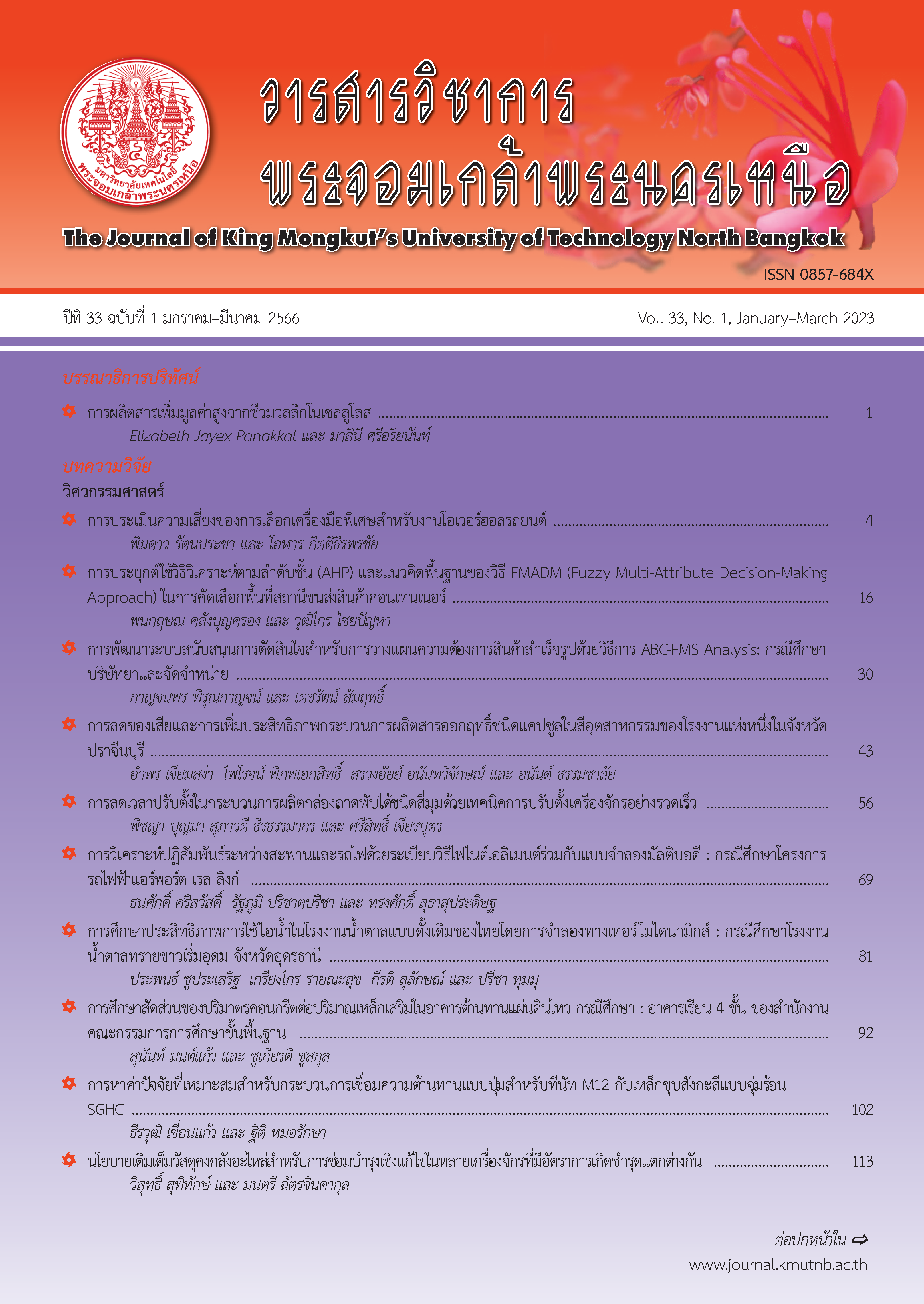การพัฒนาระบบสนับสนุนการตัดสินใจสำหรับการวางแผนความต้องการสินค้าสำเร็จรูป ด้วยวิธีการ ABC-FMS Analysis กรณีศึกษา: บริษัทผลิตยาและจัดจำหน่าย
Main Article Content
บทคัดย่อ
งานวิจัยนี้พัฒนาระบบสนับสนุนการตัดสินใจ (DSS) สำหรับการวางแผนความต้องการสินค้าสำเร็จรูป ให้กับบริษัทผลิตยาและจัดจำหน่ายแห่งหนึ่ง เพื่อแก้ปัญหาสินค้าซึ่งยังไม่สามารถส่งมอบได้ตามคำสั่งซื้อของลูกค้า (Backorder) โดยในการศึกษานี้ DSS ถูกพัฒนาขึ้นบนพื้นฐานหลักการการจัดกลุ่มประเภทสินค้าคงคลังจากมูลค่าสินค้าและความถี่ในการขายสินค้า (ABC-FMS Matrix Analysis) รวมทั้งกำหนดเงื่อนไขการสั่งซื้อสินค้าตามจำนวนขนาดสั่งซื้อสินค้าขั้นต่ำให้สอดคล้องความต้องการสินค้าสำเร็จรูปที่แท้จริง จากการนำระบบสนับสนุนการตัดสินใจที่พัฒนาขึ้นไปใช้งานจริง พบว่า สามารถลดรายการที่เกิด Backorder ลงเฉลี่ย 19 รายการต่อเดือน (จากเฉลี่ย 30 รายการต่อเดือนในปี 2562) ซึ่งทำให้จำนวนเงิน ค่าปรับที่เกิดจาก Backorder มีจำนวนลดลงเฉลี่ย 0.7 ล้านบาทต่อเดือน (จากเฉลี่ย 1.4 ล้านบาทต่อเดือนในปี 2562) หรือ สามารถลดลงร้อยละ 50.0 รวมถึงยังสามารถลดต้นทุนถือครองสินค้าคงคลังลดลงร้อยละ 14.0
Article Details

อนุญาตภายใต้เงื่อนไข Creative Commons Attribution-NonCommercial-NoDerivatives 4.0 International License.
บทความที่ลงตีพิมพ์เป็นข้อคิดเห็นของผู้เขียนเท่านั้น
ผู้เขียนจะต้องเป็นผู้รับผิดชอบต่อผลทางกฎหมายใดๆ ที่อาจเกิดขึ้นจากบทความนั้น
เอกสารอ้างอิง
A. Segerstedt, “Cover-time planning/takt planning: A technique for material requirement and production planning,” International Journal of Production Economics, vol. 194, pp. 25–31, 2017.
R. Patil and G. Singh, “Inventory management and analysis in an orthodontic practice,” Seminars in Orthodontics, vol. 22, no. 4, pp. 280–288, 2016.
O. B. Ammar, A. Dolgui, F. Hnaien, and M. A. Louly, “Supply planning and inventory control under lead time uncertainty,” presented at the 7th International Federation of Automatic Control, Saint Petersburg, Russia, Jun. 19–21, 2019.
M. I. Nofal and Z. M. Yusof, “Integration of business intelligence and enterprise resource planning within organizations,” in Proceedings 4th International Conference on Electrical Engineering and Informatics (ICEEI), 2013, pp. 658–655.
G. Stecca, I. Braffo, and T. Kaihara, “Design and operation of strategic inventory control system for drug delivery in healthcare industry,” in Proceedings International Federation of Automatic Control, 2016, pp. 904–909.
M. S. Kumar and B. A. Chakravarty, “ABC-VED analysis of expendable medical stores at a tertiary care hospital,” Medical Journal Armed Forces India, vol. 71, pp. 24–27, 2015.
M. A. Millstein, L. Yang, and H. Li, “Optimizing ABC inventory grouping decisions,” International Journal of Production Economics, vol. 148, pp. 71–80, 2014.
J. Paphiwdee and A. Kengpol, “Development of database management program for recording computer and accessory: A case study in electronic industrial,” The Journal of KMUTNB, vol. 30, no. 3, pp. 432–442, 2020 (in Thai).
W. Shunjin, “Design of purchase-sale-inventory business software base on excel,” in Proceedings National Conference on Information Technology and Computer Science (CITICS), 2012, pp. 870–873.
C. Jiang, “Integrating the use of spreadsheet software and VBA in inventory simulation,” Journal of Software, vol. 5, no. 5, pp. 498–505, 2010.
J. C. Man and J. O. Strandhagen, “Spreadsheet application still dominates enterprise resource planning and advanced planning systems,” in Proceedings International Federation of Automatic Control, 2018, pp. 1224–1229.
L. C. Gupta, C. K. Gupta, B. B. Jain, and M. G. Garg, “ABC and VED analysis in medical stores inventory control,” Medical Journal Armed Forces India, vol. 63, no. 4, 2007.
N. Susarla and I.A. Karimi, “Intelligent decisionsupport tools for effective and integrated operational planning in pharmaceutical plants,” in Proceedings of the 11th International Symposium on Process Systems Engineering, 2012, pp. 1165–1169.
M. Ketkar and O. S. Vaidya, “Developing ordering policy based on multiple inventory classification schemes,” in Proceedings International Conference on Trade Markets and Sustainability, 2013, pp. 180–188.
D. Devarajan and M. S. Jayamohan, “Stock control in a chemical firm: Combined FSN and XYZ analysis,” in Proceedings International Conference on Emerging Trends in Engineering Science and Technology (ICETEST), 2015, pp. 562–567.

